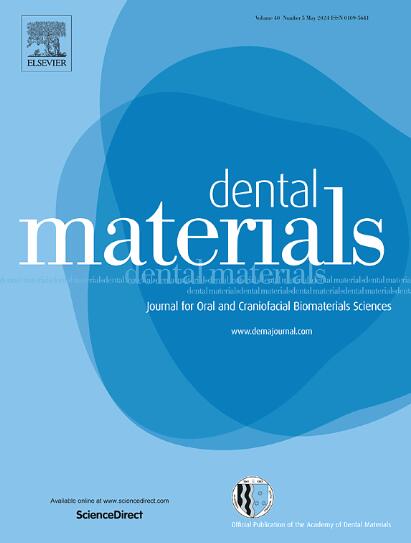通过研磨和3d打印全轮廓氧化锆的光固化修复复合材料,用于胶粘剂。
IF 4.6
1区 医学
Q1 DENTISTRY, ORAL SURGERY & MEDICINE
引用次数: 0
摘要
目的:评价不同氧化锆成分和制造工艺对光辐照度(LI)的影响,测量这些氧化锆等级下单光固化恢复性复合材料的转化度(DC),并评价各自的氧化锆微观结构。方法:六种牙用氧化锆等级(GC - HT、GC - UHT [GC];武士刀HT,武士刀UTML [Kuraray Noritake];Lava aesthetic, Lava Plus[3 M Oral Care])按照制造商的说明进行切割和烧结。根据前期研究,制备了一种3d打印氧化锆级(XJet [XJet])。氧化锆板研磨成4种厚度(0.5、1.0、1.5、3.0 mm)。通过两个光固化单元(Demi Plus [Kerr], Bluephase G4 [Ivoclar]),使用光谱学测量了这些氧化锆中的LI。修复复合材料(Clearfil AP-X [Kuraray Noritake])通过氧化锆板光固化,光固化后5 min, 24 h和1 w用微拉曼光谱测定DC。LI和DC数据的统计分析包括线性混合效应模型和多因素方差分析。用扫描电镜对氧化锆进行显微结构分析。结果:氧化锆类型、厚度和LCU对LI有显著影响(p )。意义:尽管存在明显的光衰减,但通过氧化锆光固化的复合材料在几乎所有厚度下的DC都接近没有氧化锆介入的DC, 7个氧化锆等级中的5个。此外,制造过程似乎不影响LI或DC。本文章由计算机程序翻译,如有差异,请以英文原文为准。
Light-curing of restorative composite through milled and 3D-printed full-contour zirconia for adhesive luting
Objectives
To evaluate the effect of different zirconia compositions and manufacturing processes on the light irradiance (LI), to measure the degree of conversion (DC) of solely light-curing restorative composite underneath these zirconia grades and to evaluate the respective zirconia microstructures.
Methods
Six dental zirconia grades (GC HT, GC UHT [GC]; Katana HT, Katana UTML [Kuraray Noritake]; Lava Esthetic, Lava Plus [3 M Oral Care]) were cut and sintered per manufacturer instructions. One 3D-printed zirconia grade (XJet [XJET]) was prepared according to previous research. Zirconia plates were ground to four thicknesses (0.5, 1.0, 1.5, 3.0 mm). The LI through these zirconias was measured using light spectrometry using two light-curing units (Demi Plus [Kerr], Bluephase G4 [Ivoclar]). Restorative composite (Clearfil AP-X [Kuraray Noritake]) was light-cured through the zirconia plates and the DC was determined by micro-Raman spectrometry 5 min, 24 h and 1 w after light-curing. Statistical analysis of LI and DC data involved linear mixed-effects modelling and multi-way ANOVA. Microstructural analysis of zirconia was performed by scanning electron microscopy.
Results
Zirconia type and thickness, and LCU had a significant effect on LI (p < .0001). DC significantly increased over time (p < .0001) and was not influenced by curing-light attenuation if LI reached at least 40 mW/cm². Increased yttria content resulted in an increased zirconia grain size.
Significance
Despite significant light attenuation, DC of composite light-cured through zirconia at almost all thicknesses, approached DC measured without zirconia interposition for five out of seven zirconia grades. Additionally, the manufacturing process did not seem to influence LI or DC.
求助全文
通过发布文献求助,成功后即可免费获取论文全文。
去求助
来源期刊

Dental Materials
工程技术-材料科学:生物材料
CiteScore
9.80
自引率
10.00%
发文量
290
审稿时长
67 days
期刊介绍:
Dental Materials publishes original research, review articles, and short communications.
Academy of Dental Materials members click here to register for free access to Dental Materials online.
The principal aim of Dental Materials is to promote rapid communication of scientific information between academia, industry, and the dental practitioner. Original Manuscripts on clinical and laboratory research of basic and applied character which focus on the properties or performance of dental materials or the reaction of host tissues to materials are given priority publication. Other acceptable topics include application technology in clinical dentistry and dental laboratory technology.
Comprehensive reviews and editorial commentaries on pertinent subjects will be considered.
 求助内容:
求助内容: 应助结果提醒方式:
应助结果提醒方式:


